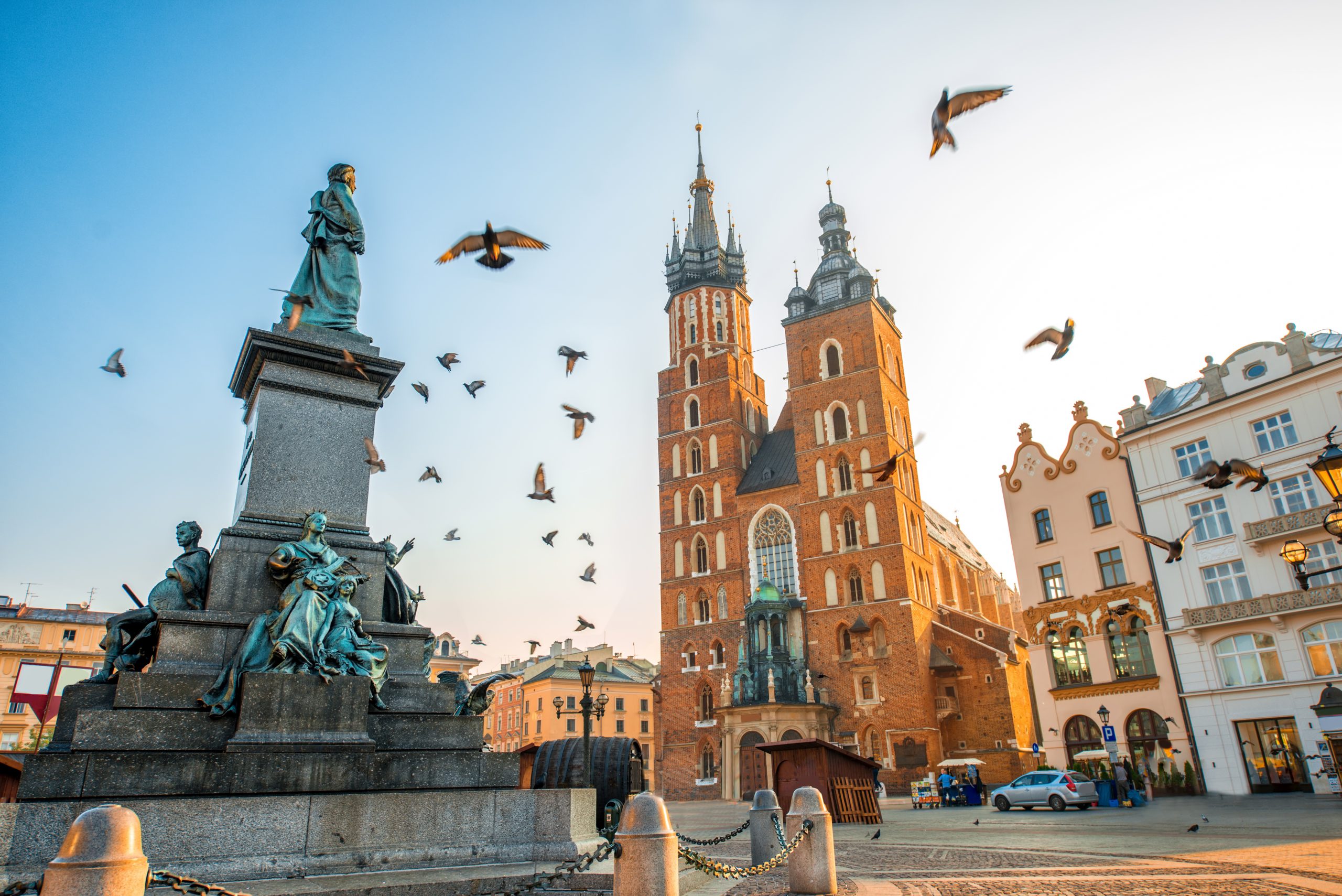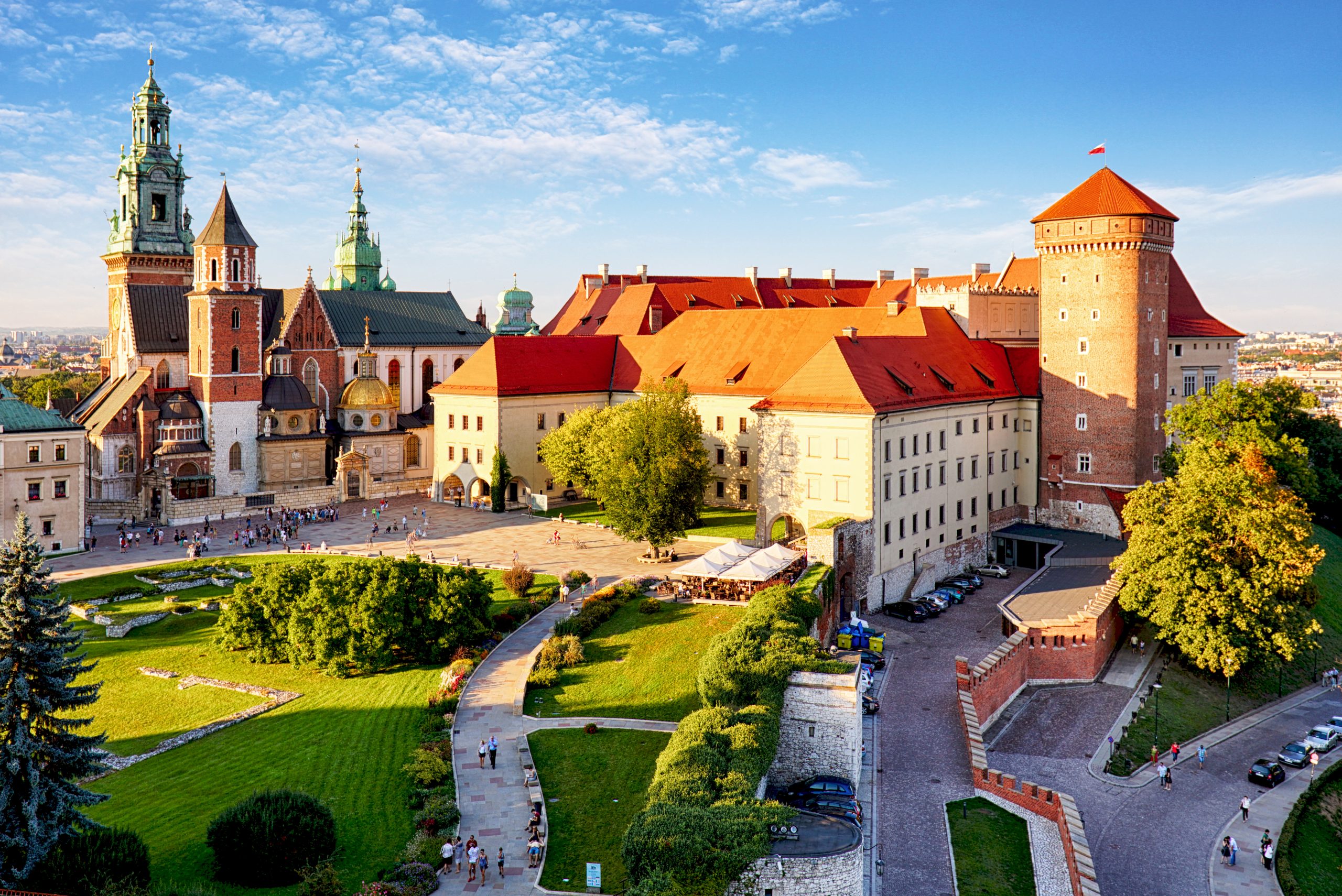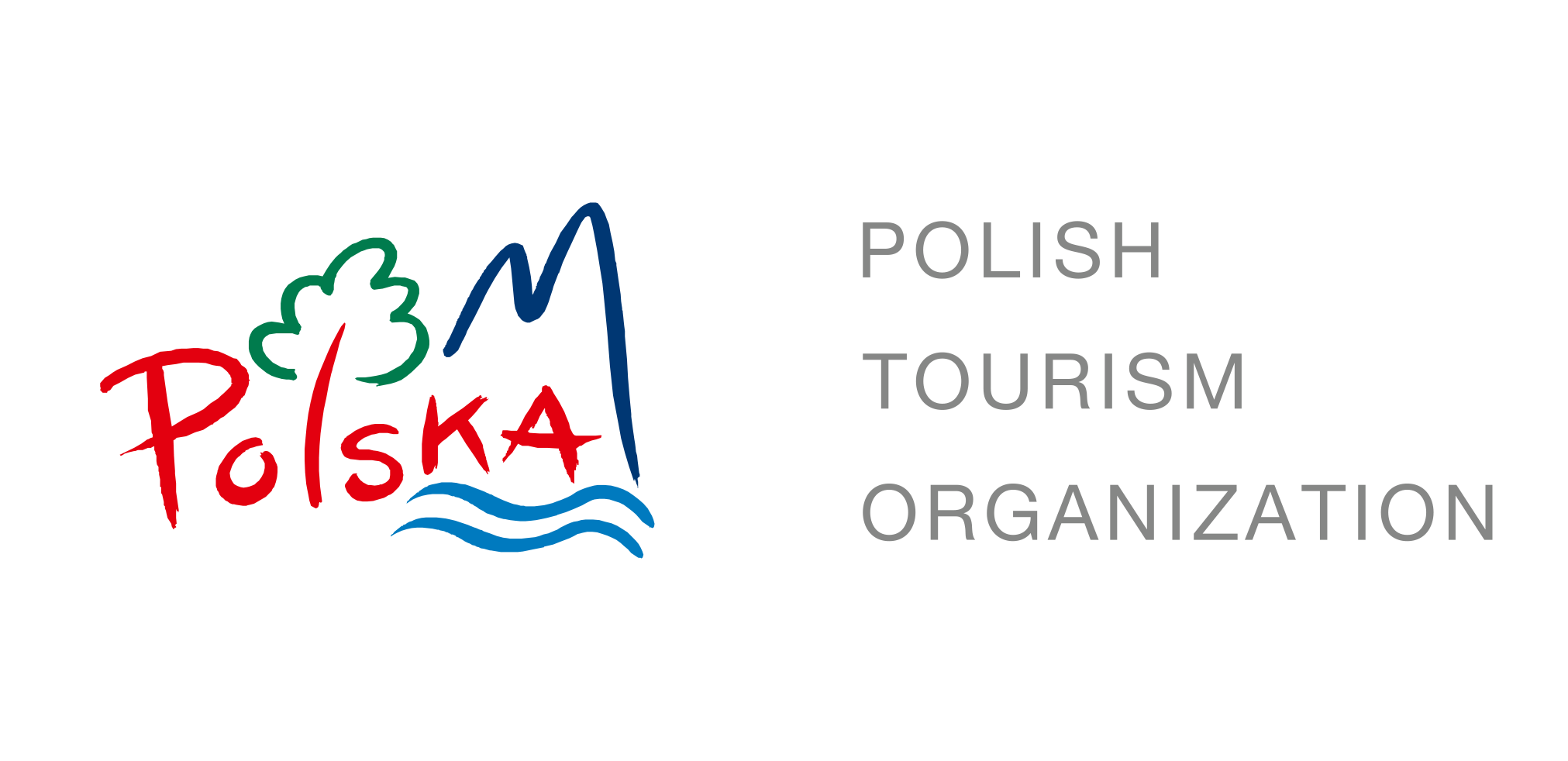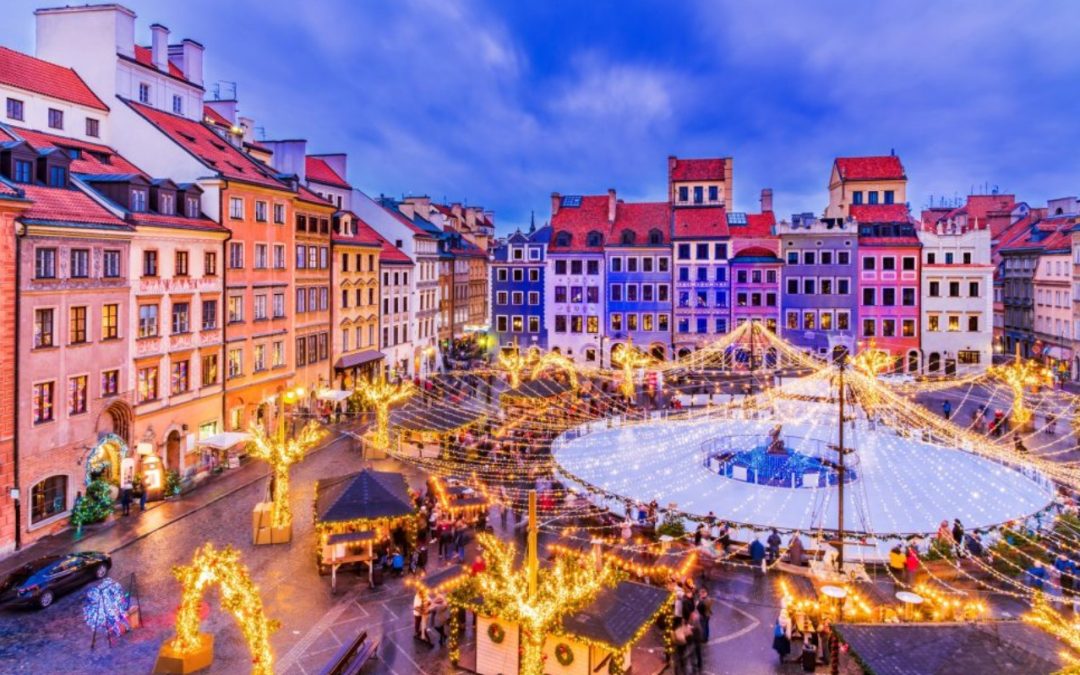When the first snowflakes settle gently on the rooftops of Poland’s centuries-old towns, something extraordinary begins to unfold. Streets once bustling with hurried footsteps transform into wonderlands of light, laughter, and warmth. Aromas of mulled wine and roasted almonds fill the air, choirs sing carols under twinkling lights, and wooden stalls brim with treasures crafted by local artisans. Christmas in Poland is more than a season; it’s a story woven from centuries of faith, folklore, and festivity.
Poland’s Christmas markets capture that story beautifully. From the cobbled squares of Kraków to the Baltic charm of Gdańsk (known as the best Christmas market in Europe), each market reflects the country’s deep-rooted traditions while offering a modern touch of joy. Let’s take a journey through Poland during its most magical time of year — a season of glowing lights, hearty food, and the unmistakable spirit of togetherness.
The Heartbeat of a Polish Christmas
Before diving into the markets themselves, it’s worth understanding the heartbeat of a Polish Christmas. In Poland, the season officially begins on December 6th, St. Nicholas Day, when children wake up to find sweets and small gifts tucked into their shoes. Yet the heart of Christmas beats strongest on December 24th, Wigilia, the Christmas Eve supper.
On this evening, families gather around tables that shimmer with candlelight and share twelve meatless dishes, one for each of the apostles. The feast begins only after the first star appears in the night sky, symbolizing the Star of Bethlehem. Straw is often placed under the tablecloth to represent the manger, and an empty seat is left open for an unexpected guest or the spirit of a departed loved one. It’s a beautiful blend of faith and folklore that captures the Polish soul.
That same warmth and reverence carry over to the Christmas markets, which open weeks before Wigilia, inviting locals and travelers alike to step into a living postcard of Polish winter.
Kraków: The Timeless Jewel of Christmas
If there is one city that could claim the crown of Polish Christmas markets, it would be Kraków. Every winter, the city’s UNESCO-listed Main Market Square becomes a glittering village of wooden chalets and festive stalls.
As the towers of St. Mary’s Basilica rise against the night sky, the air fills with the scent of pierniki (spiced gingerbread), grilled oscypek (smoked mountain cheese served with cranberry jam), and warm grzaniec galicyjski, a spiced mulled wine unique to the region. The market stretches across Rynek Główny, where vendors sell everything from hand-carved wooden toys to delicate glass ornaments and woolen slippers from the Tatra Mountains.
One of Kraków’s most distinctive traditions is the Szopka Krakowska, or nativity scene competition. These intricate, colorful models, often resembling miniature Gothic cathedrals, are crafted by local artists and displayed proudly in the square each December. The tradition dates back to the 19th century and has even earned UNESCO recognition for its cultural significance.
Strolling through Kraków’s Christmas market feels like walking into a fairy tale – one where the scent of cinnamon mingles with the sound of carolers, and every corner reveals a piece of Poland’s soul.
Wrocław: The City of Dwarfs and Festive Dreams
Wrocław, a city of bridges and legends, has one of the most enchanting Christmas markets in Central Europe. Centered around the Market Square and the Old Town Hall, Wrocław’s Jarmark Bożonarodzeniowy (Christmas Market) is an explosion of color, sound, and holiday spirit.
The market’s architecture alone sets it apart. Towering wooden gates and glowing windmills welcome visitors into a maze of stalls selling handmade crafts, Polish ceramics, and wool scarves woven in the nearby mountains. You’ll find storytellers entertaining children, elves posing for photos, and the city’s famous dwarfs — tiny bronze statues scattered throughout the streets — dressed up for the holidays.
Wrocław’s market is particularly beloved for its international flair. Alongside traditional Polish treats, you can sample Hungarian chimney cakes, German sausages, and Swiss chocolate. The atmosphere is both cozy and cosmopolitan, a reflection of the city’s layered history and youthful energy.
Gdańsk: A Baltic Wonderland
On the northern coast, Gdańsk offers a Christmas experience infused with maritime charm. The city’s market, held in the historic Targ Węglowy (Coal Market), combines the elegance of its Hanseatic architecture with the warmth of Polish holiday traditions.
Here, you can wander through rows of red-roofed chalets while snowflakes drift down over the amber-lit streets. Gdańsk’s market is particularly known for its romantic atmosphere — there’s even a Lovers’ Lantern, where couples can make wishes for the coming year. Nearby, a Ferris wheel offers panoramic views of the old town’s spires and the Motława River glistening under the winter night.
Don’t miss the local delicacies: smoked fish, sweet pierniki from Toruń, and regional mulled beer, a Baltic twist on the classic grzaniec. And if you’re lucky, you might catch a performance of the city’s Christmas parades, complete with angels, shepherds, and carolers dressed in traditional costumes.
Warsaw: A Modern Celebration of Tradition
Poland’s capital transforms into a modern winter wonderland that bridges the old and the new. Warsaw’s main Christmas market unfolds in the Castle Square beneath the Royal Castle, where a towering Christmas tree illuminates the night. The nearby Old Town, with its pastel facades and cobblestone alleys, becomes a playground for families and visitors.
What makes Warsaw special is the blend of heritage and innovation. You can browse for folk art, sip on hot chocolate infused with chili, or lace up your skates at the open-air rink that winds through the Old Town’s heart. The market stalls showcase contemporary Polish design alongside rustic crafts, giving a glimpse into how the country honors its past while embracing the present.
Even as skyscrapers glimmer in the distance, the Christmas markets here feel deeply personal – a reminder that even in a fast-paced capital, the warmth of tradition endures.
The Flavors of Polish Christmas
Poland’s Christmas markets are not just about shopping or sightseeing; they’re about tasting the season itself. Food is central to the Polish festive spirit, and the markets are a feast for every sense.
You’ll find pierogi stuffed with cabbage and mushrooms, served hot from sizzling pans. There are steaming cups of barszcz (beetroot soup), often paired with miniature dumplings. Try a slice of makowiec, a sweet poppy seed roll, or sernik, a creamy Polish cheesecake that melts in your mouth. And of course, no visit is complete without oscypek from the Tatra region, a smoky, salty cheese grilled to perfection and topped with cranberry sauce.
Wash it all down with grzaniec, Poland’s answer to mulled wine, or hot mead made from honey, one of the country’s oldest traditional drinks. Each sip and bite tells a story of Poland’s rural roots and its enduring love for homemade flavors.
Crafts, Culture, and Connection
Beyond the food and festivities, Polish Christmas markets offer something deeper — a chance to connect. Each market stall is a window into local craftsmanship and culture. You’ll see artisans carving wood into ornaments, weaving intricate lace, and painting colorful folk patterns known as wycinanki.
Visitors often find themselves chatting with vendors, learning the stories behind their crafts, and discovering how certain designs or materials have been passed down for generations. It’s a living museum of Polish artistry, open to anyone willing to look a little closer.
The Spirit That Lingers
What truly sets Poland’s Christmas markets apart is the sense of authenticity that runs through them. There’s no rush or commercial frenzy — instead, a quiet joy hums in the air. Whether you’re sipping hot wine in Kraków, skating in Warsaw, or strolling beneath the fairy lights of Gdańsk, you feel part of something timeless.
In the glow of each market’s lanterns, strangers share smiles, musicians fill the night with carols, and families gather to make memories. The markets aren’t just places to buy gifts; they’re places to find the spirit of Christmas itself — a spirit rooted in kindness, community, and warmth amid the cold.
Planning Your Visit
If you’re dreaming of experiencing Poland’s Christmas charm, the best time to visit is from late November through December. Most markets open in the last week of November and run until just after Christmas, with some continuing into early January.
Bundle up warmly, as Polish winters can be crisp, and bring an appetite for both adventure and hearty food. Many travelers combine their market visits with exploring nearby historical sites – from Kraków’s Wawel Castle to Gdańsk’s shipyards and Wrocław’s Gothic cathedrals.
A Christmas You’ll Never Forget
Poland’s Christmas markets aren’t about extravagance or spectacle; they’re about heart. They invite you to slow down, savor the moment, and rediscover the joy of simple pleasures – a warm drink shared among friends, the laughter of children on an ice rink, the glow of lights reflecting off snow.
In every corner of Poland, from its bustling cities to its quiet villages, Christmas is a reminder that warmth isn’t found in temperature but in togetherness. And for anyone lucky enough to wander through its markets, Poland offers a Christmas that lingers — long after the snow has melted and the carols have faded, leaving behind the memory of a winter truly well spent.



Call Us
+1 877 666 3113
Email Us
letsgo@skyvacations.net
